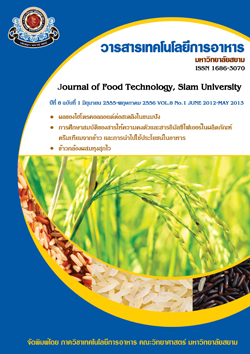ข้าวกล้องผสมหุงสุกไว
Main Article Content
Abstract
การศึกษากระบวนการผลิตข้าวกล้องผสมหุงสุกไว มีวัตถุประสงค์ เพื่อผลิตข้าวกล้องหุงสุกไวที่มีลักษณะเนื้อสัมผัส กลิ่น และคุณค่าทางโภชนาการสูงที่เป็นที่ยอมรับของผู้บริโภค โดยใช้ข้าวกล้อง 3 สายพันธุ์ ได้แก่ ข้าวกล้องขาวดอกมะลิ 105 ข้าวกล้องหอมนิล และข้าวกล้องไรซ์เบอรี่ โดยใช้วิธีอบความร้อนแห้ง (เพื่อให้เกิดรอยร้าวของเมล็ด) การแช่น้า (เพื่อให้ได้ 30% ความชื้น) การให้ความร้อนโดยหม้อนึ่งความดันไอปกติ (เพื่อให้เกิด 80% เจลาติไนซ์) และการอบแห้ง (aw<0.6) ตามลาดับ พบว่าการอบความร้อนแห้ง ไม่มีผลต่อการเกิดรอยร้าวของเมล็ด และไม่มีผลต่อการเร่งอัตราการแช่น้ำ สภาวะที่เหมาะสมของการแช่น้าของข้าวกล้องขาวดอกมะลิ 105 ข้าวกล้องหอมนิล และข้าวกล้องไรซ์เบอรี่ คือ 65°C 90 นาที, 30°C 120 นาที และ 60°C 90 นาที ตามลำดับ สภาวะที่เหมาะสมของการให้ความร้อนโดยหม้อนึ่งความดันไอปกติของข้าวกล้องขาวดอกมะลิ 105 ข้าวกล้องหอมนิล และข้าวกล้องไรซ์เบอรี่ คือ 20, 30 และ 35 นาที ตามลำดับ และการอบแห้งด้วยลมร้อนที่อุณหภูมิ 90°C นาน 2 ชั่วโมงของข้าวกล้องทั้งสามชนิดมีผลให้ค่า aw ต่ำกว่า 0.6 ซึ่งเหมาะต่อการเก็บรักษา จากการทดสอบเวลาที่ใช้ในการหุงสุกในน้ำเดือดพบว่า ข้าวกล้องวัตถุดิบทั้ง 3 สายพันธุ์ หุงสุกที่เวลา 25 นาที ส่วนข้าวกล้องหุงสุกไวทั้ง 3 สายพันธุ์ หุงสุกที่เวลา 10 นาที ซึ่งย่นระยะเวลาในการหุงสุกได้ถึง 15 นาที จากการวิเคราะห์สมบัติทางความหนืดของเพสต์ข้าวกล้อง ด้วยเครื่อง Rapid Visco Analyser (RVA) พบว่าค่าความหนืด ณ จุดที่เกิดพีก (peak viscosity) ค่าความหนืดสุดท้าย (final viscosity) และค่า setback ของแป้งข้าวกล้องหุงสุกไวทั้ง 3 ชนิดมีค่าลดลงเมื่อเปรียบเทียบกับข้าวที่ไม่ผ่านกระบวนการความร้อน เมื่อนำข้าวทั้ง 3 สายพันธุ์ที่ผ่านกระบวนการผลิตที่เหมาะสมมาผสมกันในอัตราส่วน 1:1:1 และหุงสุกโดยหม้อหุงข้าวไฟฟ้าเพื่อทดสอบการชิม พบว่ามีการยอมรับทางประสาทสัมผัสในด้านความชอบโดยรวมมากกว่าข้าวกล้องผสม (1:1:1) ที่เป็นวัตถุดิบ โดยมีความแตกต่างอย่างมีนัยสำคัญทางสถิติ (p≤0.05)
Quick-Cooking Mixed Brown Rice
The production of a quick-cooking mixture of 3 types of brown rice (Khao Dok Mali 105, Homnin and Riceberry) was conducted in order to improve texture, aroma and nutrients to meet consumer demand. Four processes were used to produce quick-cooking brown rice including: pre-dry heating (to create cracking on the surface of the rice and to increase the rate of hydration during soaking); soaking (to gain 30% moisture); steaming (to obtain 80% gelatinize); and dry heating. The pre-dry heat process did not affect the rate of hydration compared to the rice which was not pre-dried. The proper soaking conditions of the 3 types of brown rice, Khao Dok Mali 105, Homnin and Riceberry, were 65°C 90 min., 30°C 120 min. and 60°C 90 min. respectively. The proper period of atmospheric steam cooking for each, Khao Dok Mali 105, Homnin and Riceberry, was 20, 30 and 35 min. respectively. Dry heat at 90°C for 2 hours was used to reduce the moisture of the rice to aw < 0.6 which was suitable for storage. The timing for cooking rice in boiling water was explored. The un-processed brown rice (raw brown rice) was fully cooked in 25 min but the processed quick-cooking brown rice was fully cooked in 10 min. These results indicate that processed, quick-cooking brown rice can be cooked faster than un-processed brown rice for 15 min. The physical property of the brown rice was investigated by Rapid Visco Analyser (RVA). Results showed that levels of peak and final viscosity and setback of 3 types of processed quick-cooking brown rice lower than the 3 types of raw brown rice. Sensory evaluation of the 3 types of quick-cooking brown rice mixed together (1:1:1) indicated a significant overall preference (p≤0.05) compared to the 3 mixed types of raw brown rice (1:1:1)
Article Details
Copyrights of all articles in the Journal of Food Technology available in print or online are owned by Siam University and protected by law.


